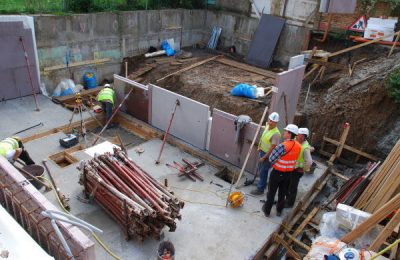Nowadays, the terms mews or mews house might conjure up images of trendy and chic houses, hidden gems located along picturesque cobblestone lanes and alleys, in some of London’s most exclusive areas. But what is a mews, and where did they originate?
Flighty beginnings
The word mews is late middle English, deriving from the French word ‘muer’, (mew) meaning ‘to moult’. Trained hawks were usually confined to either a cage or a building when they were moulting, so the word mew came to refer to the place where they were kept, as well as being a verb meaning ‘to confine’, either in a place or a situation.
This word usage dates back to Shakespeare, who uses it in The Taming of the Shrew: “What, will you mew her up, Signor Baptista?”, as well as in Richard III, ‘This day should Clarence closely be mewed up’.
The word took on the meaning of ‘converted dwellings’ in the 19th century.
 Royal Stables in the Mews Charing Cross, 1793 © Royal Collection
Royal Stables in the Mews Charing Cross, 1793 © Royal Collection
Royal connection
In the 14th century, the royal hawks were kept at the King’s Mews while moulting, during which time they were not used for hunting. Located at the current site of the National Gallery at Charing Cross, the Mews were used for a century until the reign of King Henry VII.
After the building was destroyed in a fire during the reign of Henry VIII, they were rebuilt as stables. The name ‘Mews’ was retained, although the new building now served an equine rather than an avian purpose.
The current Royal Mews are located at Buckingham Palace, built there during the rebuilding of the Palace by John Nash for George IV. It includes a riding school which was established by Queen Victoria during her reign, who also established a school for the children of families working at the Mews. All of Queen Victoria’s children learned to ride at the Royal Mews.
The evolution of Mews
The word mews became more widely used in the 18th and 19th century, referring to stables and the service streets they were located on in cities (primarily London), rather than a stand-alone stable block.
In the Georgian era, architecture was characterised by symmetry and balance, and conformity in the style of house-fronts was desirable. During this period, towns and cities were expanding quickly, and construction in London was at a height with rebuilding of the city following the Great fire of London in 1666. This gave rise to rows of identical terraced houses, with many of these still remaining today.
Georgian town planning requirement was for primary, secondary, and tertiary accommodation to be separated. With increased use of horses and carriages, stables – considered tertiary areas – were a necessary part of life for wealthy families, along with a staff of servants. To situate the horses and carriages away from the main houses, and to preserve the aesthetic of the primary accommodations, mews were constructed in a row at the back, with access via a secondary road. This arrangement also kept the smell and dirt of the horses away from the occupants of the house when they were not in use.
Mews houses usually consisted of stables and a carriage house on the ground floor, with servants quarters consisting of a few meagre rooms above. As a feature, most mews houses did not have windows facing towards the main house, so owners could stroll in their garden without fear of being spied on by servants. Similarly, the basements of the houses were often connected to the mews via an underground tunnel, so servants could go back and forth between the buildings unseen.
 The Mews of London by Barbara Rosen and Wolfgang Zuckermann, 1982 – Image Source
The Mews of London by Barbara Rosen and Wolfgang Zuckermann, 1982 – Image Source
Decline and Rebirth of the Mews House
In the 20th century, the rise of the motorcar gradually eliminated the need for horses and stables. At the same time, after World War I and World War II, the number of people who were wealthy enough to live in such grand mansions declined greatly, and the servant class decreased as society became more equal.
Mews houses began to fall into disrepair, and many were taken over by squatters, with the word mews coming to refer to seedy back streets. Some were bought for low prices by artists, among them painter Francis Bacon. Mews houses often contain garages as well which is unusual in London, so race car drivers such as James Hunt began to buy mews houses so they could live above their cars. Mews also began to be converted into commercial properties such as garages and print firms.
As is often the case, gentrification began to occur in mews, as the wider public caught on to the advantages of the areas that artists had adopted and made desirable. In the 1960’s, mews houses became popular as converted homes, and were also remodelled into modern houses. As mews houses rarely have listed status, they lend themselves to modernisation very well as they can be radically altered inside with few restrictions.
Because they were originally constructed to serve the upper classes, mews houses are usually located in the most sought after areas, such as Notting Hill, Kensington, and Chelsea. The cobble stoned streets, which were originally constructed to withstand wear from horses’ hooves, now give the mews a quaint and picturesque look. With their almost traffic-free streets, tucked away behind the main road, enclosed and often a cul-de-sac, mews houses have an innate character and old world charm.
 A street of mews houses (Dunworth Mews) in Notting Hill, London, England by Adrian Pingstone – Image Source
A street of mews houses (Dunworth Mews) in Notting Hill, London, England by Adrian Pingstone – Image Source
 Essex Mews, www.rarespace.co
Essex Mews, www.rarespace.co
Mews Houses in Popular Culture
A survey in 2015 of the Mews in London estimated that 433 original and surviving mews are still in existence. Over the past few decades, mews houses have been the backdrop for crime dramas on TV, as well the residence of John Steed, suave secret agent from the TV series The Avengers. A mews house was also the romantic location for the iconic scene between Keira Knightley and Andrew Lincoln in Love Actually.
In real life, a mews house was the meeting place for the selling of state secrets to a prostitute in the Profumo crisis, as well as where serial killer John Christie carried out his murders. On the lighter side, iconic actor Michael Caine was a famous resident of a mews house in the 1960’s, as was celebrated author Agatha Christie. Queensgate Mews is also reputedly the location of London’s first petrol pump.
Rags to Riches
From their humble beginnings, mews houses have gone up in price almost exponentially since they began to be lived in as converted homes. One home close to Hyde Park described as a ‘pokey four-room flat above a garage’ in the 1950’s had, by 1982, sold for £200,000. Six years later, the home had doubled in value, and in 1995, sold for £525,000. By 2007, the same home had an estimated value of £2m.
Mews houses can be thoroughly modernised, not only through a remodelling face-lift, but through the addition of green and sustainable fixtures such as solar panels and air-source heat pumps, becoming true 21st century homes.
Many mews houses have been extended sideways into adjoining properties, or upwards to add another storey or terrace, increasing the square footage as well as the value of the home, which can go up to £1250 per square foot or more. Garages, often a hard to find feature of a home in London, are valued at the same price per square foot as the residential accommodation.
Many long term owners, however, are choosing to live in their homes rather than cashing in on the investment, as mews houses can be an oasis in the middle of the busy city. Often within walking distance to parks, trendy shops, restaurants, bars, and excellent schools, mews also have a community feel. Residents often know each other, creating a close-knit genuine neighbourhood feel.
Remodelling of a Mews House
Alan, with the help of MSMR Architects, has completely renovated a mews house in Central London. Alan took back the house so that little was left but the external walls, and set about creating what can only be described as the height of luxury.
Video Source – YouTube.



